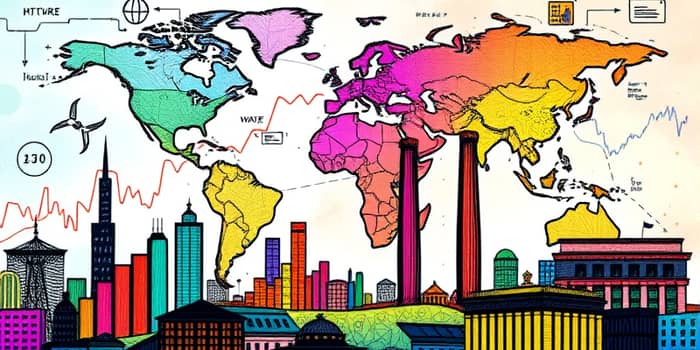As the world economy navigates a maze of policy shifts, market uncertainties, and structural transformations, investors and policymakers face critical decisions. This article offers an in-depth exploration of current trends, emerging challenges, and actionable strategies to thrive in an evolving financial landscape.
The Current State of the Global Economy
Recent forecasts paint a sobering picture. The IMF’s April 2025 World Economic Outlook warns of a post–pandemic slowdown, projecting global growth to dip below historical averages.
S&P Global maintains its forecast at 2.2% for 2025 and 2.4% for 2026, but these figures follow several revisions downward. Meanwhile, the World Bank sees a modest 2.7% growth pace in 2025–26, signaling a new normal of subdued expansion.
Inflation remains sticky. Core CPI is forecast to hover near 3%, limiting central banks’ room to cut rates. The result is a high-for-long monetary policy stance that weighs on consumer spending and business investment.
Five Transformational Forces Shaping Global Finance
The pandemic accelerated five structural shifts—often called the Five D’s—that will define markets for years to come:
- Deglobalization: Rising trade barriers and supply chain reshoring have tripled restrictions since 2019, fueling costs and volatility.
- Decarbonization: Climate initiatives are redirecting capital toward renewables and green technologies, reshaping energy markets.
- Demographics: Aging populations in advanced economies are squeezing labor supplies and slowing productivity growth.
- Debt: Record public and private debt levels constrain fiscal stimulus and elevate default risks.
- Digitalization: Fintech innovation, blockchain adoption, and AI-driven platforms are redefining financial services.
Together, these forces are not just cyclical headwinds but represent a structural transition. Stakeholders must embrace flexible strategies that account for trade fragmentation, green investment cycles, shifting labor dynamics, debt management, and rapid technological change.
Regional Outlooks and Trade Dynamics
Growth prospects diverge markedly by region. East Asia and Europe face moderate slowdowns, while Latin America and Sub-Saharan Africa could see upticks driven by domestic demand. China’s economy, buoyed by recent stimulus, has surprised on the upside.
Trade tensions remain a wildcard. Faster-than-expected tariff rollbacks between the US and China offer a glimmer of hope, but overall restrictions continue to mount. In this environment, companies must diversify supply chains and explore new markets to mitigate geopolitical risk.
Banking Sector Resilience and Regulatory Shifts
Regulators in the United States are proposing a 16% increase in high-quality capital for major banks, demanding an extra $2 of equity for every $100 of risk-weighted assets. The aim is a more resilient banking system with minimal impact on funding costs.
These measures, while prudent, demand strategic planning from banks. Institutions must optimize capital allocation, enhance risk management, and explore fee-based revenue models to sustain profitability in a tighter margin environment.
Investment Trends and Market Opportunities
J.P. Morgan Research forecasts higher dispersion across stocks, sectors, and regions, creating fertile ground for active managers. Credit markets appear constructive, especially in high-quality corporate debt, while emerging market fixed income warrants caution due to external vulnerabilities.
Key themes to watch:
- Green bonds and sustainability-linked notes.
- Technology-driven financial platforms and digital assets.
- Healthcare and aging-related services in developed markets.
Investors should maintain flexibility, seeking mispriced opportunities in niche sectors and hedging against policy shifts that could reshape valuations quickly.
Looming Risks and Policy Recommendations
A range of downside risks could derail the recovery if unaddressed:
- Escalating trade wars and policy uncertainty.
- Resurgent inflation delaying rate cuts.
- Geopolitical conflicts disrupting markets.
- Credit stress in highly indebted economies.
- Climate-related natural disasters impacting supply chains.
To navigate these threats, policymakers should:
- Promote a stable trade framework through multilateral dialogue.
- Implement targeted fiscal reforms to balance aging-related social spending.
- Strengthen debt management frameworks and fiscal transparency.
- Accelerate climate policies with clear regulatory roadmaps.
- Foster innovation-friendly regulations for fintech and green finance.
Conclusion: Charting a Course Through Uncertainty
The global economy stands at a crossroads. While growth is moderating, the rise of new structural forces offers both challenges and opportunities. By understanding the interplay of deglobalization, decarbonization, demographics, debt, and digitalization, stakeholders can craft resilient strategies.
Investors should embrace agile portfolio management, diversify across regions and themes, and employ robust risk controls. Policymakers must balance short-term support with long-term structural reforms to foster sustainable growth.
Ultimately, those who adapt to the shifting landscape—leveraging technology, championing green initiatives, and fortifying financial systems—will emerge stronger. The journey ahead demands foresight, collaboration, and a commitment to innovation.
References
- https://www.imf.org/en/Publications/WEO/Issues/2025/04/22/world-economic-outlook-april-2025
- https://www.spglobal.com/market-intelligence/en/news-insights/research/global-economic-outlook-may-2025
- https://www.jpmorgan.com/insights/global-research/outlook/market-outlook
- https://www.worldbank.org/en/publication/global-economic-prospects
- https://www.weforum.org/stories/2025/01/5-transformational-trends-shaping-global-finance/
- https://www.brookings.edu/articles/what-is-bank-capital-what-is-the-basel-iii-endgame/
- https://www.mckinsey.com/industries/private-capital/our-insights/global-private-markets-report










